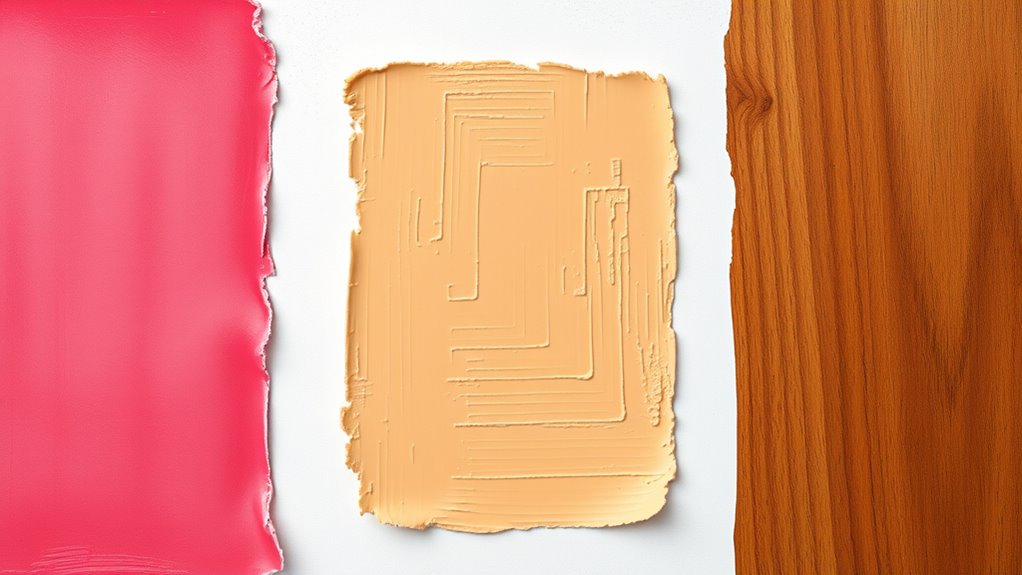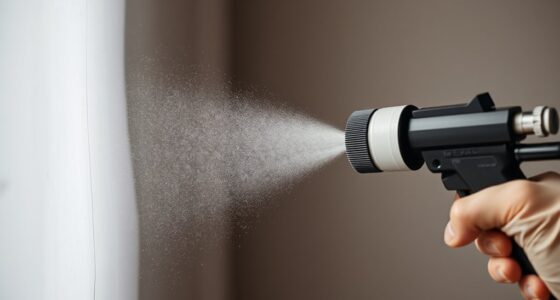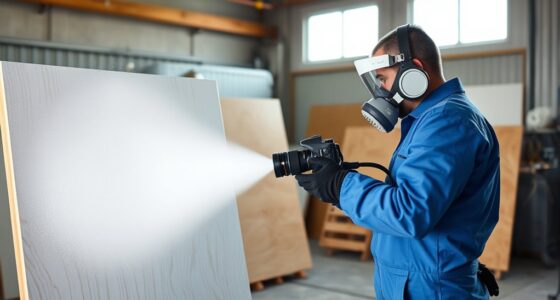When switching between paint types like latex, oil-based, or stain, start by evaluating the current surface and cleaning it thoroughly. Sand glossy or uneven areas to improve adhesion, and wipe away dust. For latex over oil-based paint, apply a primer or bonding agent; for oil-based over latex, use a deglosser or suitable primer. Proper surface preparation ensures your new finish adheres well and lasts longer. Keep exploring to learn more tips for a flawless, professional look.
Key Takeaways
- Properly clean and sand the surface to ensure adhesion when switching between paint types.
- Use a compatible primer or bonding agent to promote adhesion between different paint or stain types.
- For latex to oil-based, remove previous finishes completely and consider deglossing or priming.
- For oil-based to latex, thoroughly sand, clean, and apply a suitable primer designed for latex paints.
- Always follow manufacturer instructions for surface preparation and application to achieve durable results.

Switching between different paint types can be straightforward if you understand the proper preparation and application techniques. When moving from latex to oil-based paints or applying a stain over painted surfaces, your success depends on how well you prepare the surface and adapt your application methods. Surface preparation is especially critical because each paint type interacts differently with various materials, and failing to prep correctly can lead to peeling, uneven coverage, or a finish that doesn’t last.
First, assess the surface you’re working with. If you’re switching from latex to oil-based paint, you’ll need to clean the surface thoroughly to remove dirt, grease, or soap residues. Sanding is essential to create a slightly rough texture that helps the new paint adhere better. For glossy surfaces, a light sanding with fine-grit sandpaper can break the slick finish, providing better grip for the new coat. Wipe away dust with a damp cloth and let it dry completely before moving forward. This surface preparation step ensures the application techniques you employ will be effective and that the new paint bonds properly. Using the correct primer or bonding agent can also improve adhesion when switching paint types.
If you’re transitioning from oil-based to latex paint, the surface prep process slightly differs. Oil-based paints tend to be more durable but can be stubborn to cover. Scrape any loose or peeling paint, then sand the surface to smooth out imperfections and create a key for the new coat. It’s essential to clean the surface thoroughly afterward to remove dust and oil residues. Using a deglosser or primer designed for oil-based paints helps to create a compatible base for latex paints, ensuring a smoother application and better adhesion.
Applying stains over painted surfaces requires specific attention to surface prep as well. Since stains penetrate the wood rather than sit on top of it, you need to guarantee the surface is clean and free of any previous finishes that might block absorption. Light sanding to open the wood pores and remove any gloss or coatings is essential. After sanding, wipe down the surface to remove dust and apply a suitable wood conditioner if necessary. Proper surface prep here guarantees an even stain application and prevents blotchiness. Additionally, understanding the interactions between paint types can help you choose the right products for a successful project.
When it comes to application techniques, always follow the manufacturer’s instructions for the specific paint or stain you’re using. Use the appropriate brushes, rollers, or sprayers, and work in consistent, even strokes. Proper surface prep combined with the right application techniques will make switching between paint types smoother and result in a professional-looking finish. Remember, patience and attention to detail during surface preparation go a long way in ensuring your project’s success.
Frequently Asked Questions
Can I Mix Different Paint Types in the Same Project?
You shouldn’t mix different paint types in the same project because paint compatibility varies and can cause issues like peeling or uneven coverage. Before blending, verify proper surface preparation, such as cleaning and priming, to promote adhesion. If you must combine them, consider using a compatible primer or sealer, and test a small area first. Stick to one paint type for the best results and durability.
How Do I Properly Dispose of Leftover Oil-Based Paint?
Oh, don’t just toss that oil-based paint in the trash, thinking it’s harmless! Proper paint disposal is essential because leftover oil paint is hazardous waste. Take it to a local hazardous waste facility or recycling center—most communities have specific days for this. Seal the paint can tightly, and never pour it down the drain or onto the ground. Your trash bin isn’t a safe dump for hazardous waste!
Are There Specific Primers Needed When Switching Paint Types?
When switching paint types, you need a primer compatible with both surfaces to guarantee proper adhesion and avoid adhesion issues. For example, if you’re moving from oil-based to latex, use a bonding primer designed for that transition. This step helps prevent peeling or chipping, creating a smooth, durable finish. Always check the primer label for compatibility, and prepare your surface thoroughly for the best results.
How Long Should I Wait Between Applying Different Paint Types?
Think of painting as a delicate dance—timing is everything. You should wait at least 24 hours for latex over oil-based paint, and 4-6 hours between coats of the same type. Always consider drying times and surface preparation before switching paints. Rushing can cause peeling or uneven results. Make certain each layer is fully dry and properly prepped, and you’ll dance your way to a flawless finish.
What Are the Environmental Impacts of Switching Paints?
Switching paints can impact the environment by generating hazardous waste, especially if you don’t dispose of leftover paint properly. Opt for eco-friendly alternatives like low-VOC or zero-VOC paints to reduce air pollution and health risks. Always follow proper hazardous waste disposal guidelines to prevent contaminating soil and water. Choosing sustainable paints and responsible disposal methods helps minimize your environmental footprint when changing between paint types.
Conclusion
Switching between paint types is like changing your musical tune—each brings its own mood and magic. Embrace the journey, knowing that your brushstrokes can transform a blank canvas into a masterpiece. With every switch, you’re weaving a story, adding depth and character to your space. So, trust your instincts, and let your creativity flow freely. After all, you’re the artist, and the colors you choose are your voice—loud, bold, and uniquely yours.










